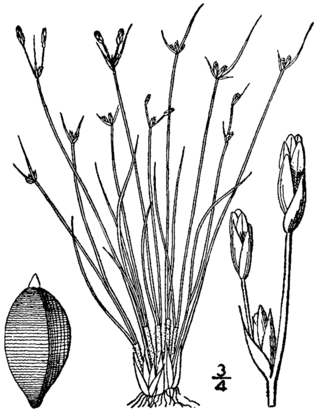
The Cyperaceae are a family of graminoid (grass-like), monocotyledonous flowering plants known as sedges. The family is large, with some 5,500 known species described in about 90 genera, the largest being the "true sedges" genus Carex with over 2,000 species.

Cyperus is a large genus of about 700 species of sedges, distributed throughout all continents in both tropical and temperate regions.

Carex is a vast genus of nearly 2,000 species of grass-like plants in the family Cyperaceae, commonly known as sedges. Other members of the family Cyperaceae are also called sedges, however those of genus Carex may be called true sedges, and it is the most species-rich genus in the family. The study of Carex is known as caricology.

Fimbristylis is a genus of sedges. A plant in this genus may be known commonly as a fimbry or fimbristyle. There are 200 to 300 species distributed worldwide. Several continents have native species but many species have been introduced to regions where they are not native. Some are considered weeds. These are typical sedges in appearance, with stiff, ridged stems and cone-shaped terminal panicles of spikelets. They are found in wet environments, and are most diverse in tropical and subtropical regions.

Dulichium is a monotypic genus of sedge containing the single species Dulichium arundinaceum, which is known by the common name threeway sedge. This is an aquatic or semi-aquatic plant of the lakes, streams, and ponds of the United States and Canada It has a wide distribution across the two countries, though noticeably absent from the Dakotas and from the Southwestern Deserts.

Fimbristylis thermalis is a species of fimbry known by the common name hot springs fimbry. It is native to the southwestern United States and northern Mexico. It has been reported from Baja California, California, Arizona, Nevada, Utah and Coahuila.

Bulbostylis neglecta, neglected tuft sedge locally, is an endemic member of the Cyperaceae of Saint Helena in the South Atlantic.

Bulbostylis capillaris is a species of sedge known by the common names densetuft hairsedge and threadleaf beakseed. It is native to much of North America, South America and the West Indies from Canada to Bolivia.

Schoenoplectus pungens is a species of flowering plant in the sedge family known as common threesquare, common three-square bulrush and sharp club-rush. It is a herbaceous emergent plant that is widespread across much of North and South America as well as Europe, New Zealand and Australia.
B. neglecta may refer to:

Carex divisa is a species of sedge known by the common names divided sedge and separated sedge. It is native to Europe, Asia, and North Africa, and considered naturalized in Australia, New Zealand, and scattered locations in North America.
Johann Otto Boeckeler was a German apothecary-botanist of Oldenburg. He specialized in the plant family Cyperaceae (sedges), of which, he was the binomial authority of many species.
Carex bulbostylis, known as the false hair sedge, is a species of sedge native to the southcentral and southeastern United States. It was first formally named by Kenneth Mackenzie in 1915. It is also known as the eastern narrowleaf sedge, thick style sedge, and globose sedge.

Bulbostylis barbata is a flowering plant in the sedge family, Cyperaceae, that is native to Western Australia.
Bulbostylis burbidgeae is a flowering plant in the sedge family, Cyperaceae, that is native to Western Australia.
Bulbostylis turbinata is a flowering plant in the sedge family, Cyperaceae that is native to Western Australia.
Bulbostylis eleocharoides is a species of plant in the family Cyperaceae first described by Robert Kral and Mark T. Strong. Its native range is Bolivia to Paraguay. No subspecies are listed in the Catalogue of Life.

Bulbostylis lichtensteiniana is a species of flowering plant in the sedge family, Cyperaceae, that is endemic to Saint Helena. Unlike other species native to Saint Helena, such as Bulbostylis neglecta, Bulbostylis lichtensteiniana does not show obvious signs of decline due to the spread of invasive plants. However the lack of decline is partially attributed to Bulbostylis lichtensteiniana being the only endemic plant to have expanded into new anthropogenic habitats.
Bulbostylis cangae is a species of flowering plant in the sedge family, Cyperaceae, that is endemic to the Serra dos Carajás in Brazil. It was first identified by Nunes et al. (2016) as part of a joint project with the Museu Paraense Emílio Goeldi and the Instituto Tecnológico Vale which identified 55 species of Cyperaceae in the Carajás National Forest and surrounding areas. The majority of these species were associated with ironstone outcrops, which are known as cangas locally.












